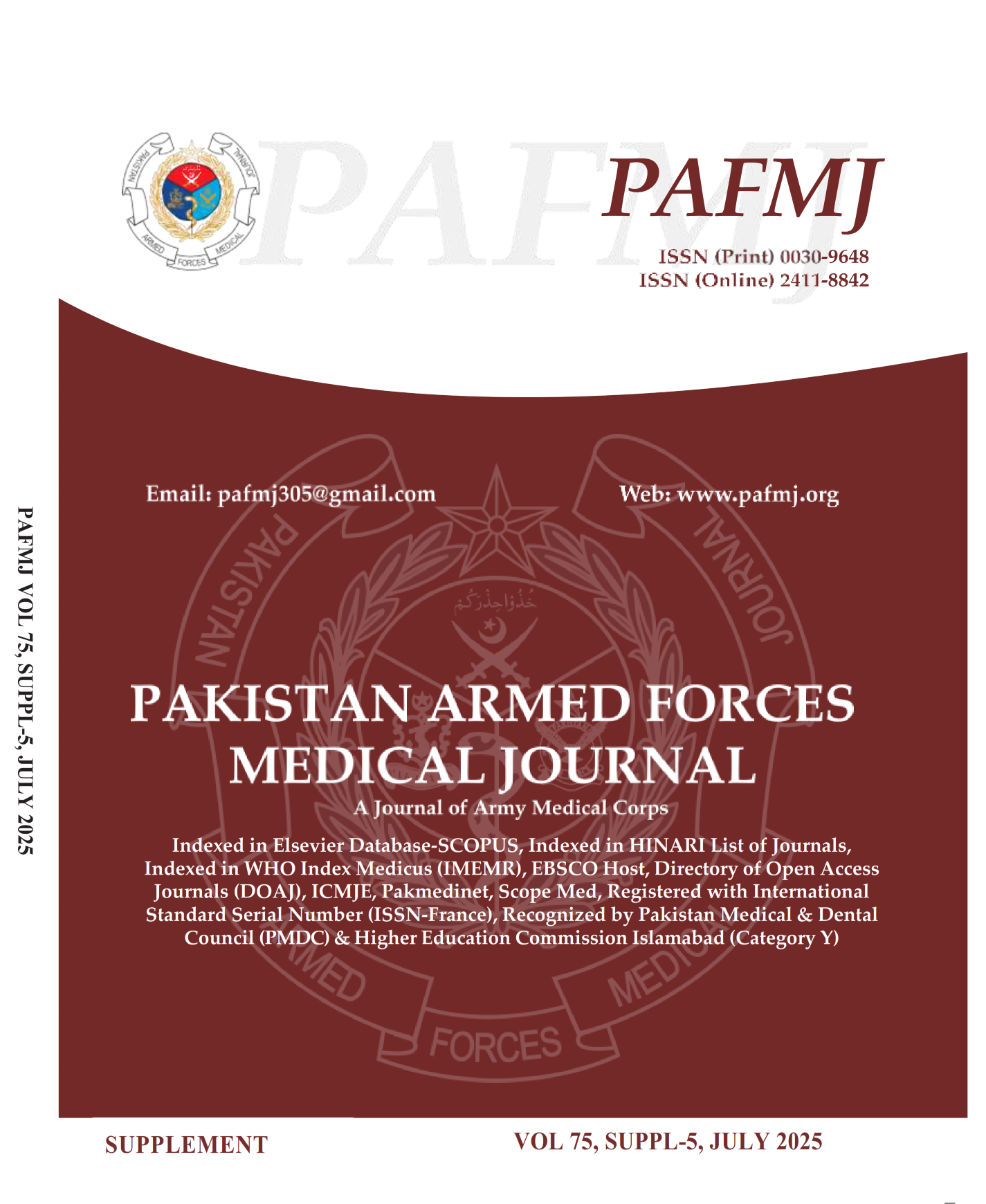Comparison of Efficacy Between Superficial Chemical Peels and Microdermabrasion for ACNE Vulgaris
DOI:
https://doi.org/10.51253/pafmj.v75iSUPPL-5.13087Keywords:
Acne vulgaris, Glycolic acid peel, Microdermabrasion, Skin of Colour (SOC).Abstract
Objective: To compare the efficacy of microdermabrasion and glycolic acid peeling in the treatment of acne vulgaris in skin of color.
Study Design: Quasi-experimental study.
Place and Duration of Study: Department of Dermatology, Pak Emirates Military Hospital, Rawalpindi Pakistan, from May 2022 to Nov 2022.
Methodology: A total of 150 patients of both gender with age 15-30 years and diagnosis of Acne Vulgaris (mild, moderate or severe) for more than 4 weeks were included. Patients who were already using oral/topical acne treatment including isotretinoin, other skin diseases and polycystic ovarian syndrome were excluded. Patients were divided into the glycolic acid peel Group (Group-A) and the micro-dermabrasion Group (Group-B). The procedure was repeated monthly for 3 months, in both Groups and assessment was done at the end of 3 months on a specially designed Performa.
Results: The mean age of the patients was 21.2±3.3 years and 21.4±3.3 years in Group-A and B, respectively. The mean duration of complaints was 11.3±1.3 weeks in Group-A while 9.7±1.1 weeks in Group B. GAG score for acne assessment was used to see the response of treatment in each Group. The females had a better response as compared to males. Moreover, the efficacy of glycolic acid peel was slightly better in the younger age Group while the efficacy of microdermabrasion showed better results in the older age Group (21 years to 30 years). The microdermabrasion was found to be more efficacious as compared to glycolic acid peeling (p=0.005).
Conclusion: The efficacy of microdermabrasion was statistically significant..
Downloads
References
Leung AK, Barankin B, Lam JM, Leong KF, Hon KL. Dermatology: how to manage acne vulgaris. Drugs Context 2021; 10: 2021-8–6;.
https://doi.org/10.7573/dic.2021-8-6
2. Vasam M, Korutla S, Bohara RA. Acne vulgaris: A review of the pathophysiology, treatment, and recent nanotechnology based advances. Biochemistry and Biophysics Reports 2023; 36: 101578. https://doi.org/10.1016/j.bbrep.2023.101578
3. Thiboutot D, Dréno B, Sanders V, Reuda MJ, Gollnick H. Changes in the management of acne: 2009-2019. J Am Acad Dermatol 2020; 82(5): 1268–1269.
https://doi.org/10.1016/j.jaad.2019.04.012
4. Baldwin H, Tan J. Effects of Diet on Acne and Its Response to Treatment. Am J Clin Dermatol 2021; 22(1): 55–65.
https://doi.org/10.1007/s40257-020-00542-y
5. Barbieri JS. Diet and Acne-Challenges of Translating Nutritional Epidemiologic Research Into Clinical Practice. JAMA Dermatol 2020; 156(8): 841–843.
https://doi.org/10.1001/jamadermatol.2020.1601
6. Dall’Oglio F, Nasca MR, Fiorentini F, Micali G. Diet and acne: review of the evidence from 2009 to 2020. Int J Dermatol 2021; 60(6): 672–685.
https://doi.org/10.1111/ijd.15390
7. Alhetheli G, Elneam AIA, Alsenaid A, Al-Dhubaibi M. Vitamin D Levels in Patients with and without Acne and Its Relation to Acne Severity: A Case-Control Study. Clin Cosmet Investig Dermatol 2020; 13: 759–765.
https://doi.org/10.2147/CCID.S271500
8. Chilicka K, Gold MH, Nowicka D. Acne vulgaris and the most popular and new cosmetological treatments. Journal of Cosmetic Dermatology 2023; 22(7): 1946–1950.
https://doi.org/10.1111/jocd.15757
9. Vanthitha PR, Vellaisamy SG, Gopalan K, Nanjappachetty G. A comparative study of the resurfacing effect of microdermabrasion versus glycolic acid peel in the management of acne scars. Journal of Pakistan Association of Dermatologists 2018; 28(2): 224–232.
10. Alam M, Omura NE, Dover JS, Arndt KA. Glycolic acid peels compared to microdermabrasion: a right-left controlled trial of efficacy and patient satisfaction. Dermatol Surg 2002; 28(6): 475–479. https://doi.org/10.1046/j.1524-4725.2002.01144.x
11. Bae IH, Kwak JH, Na CH, Kim MS, Shin BS, Choi HS. A Comprehensive Review of the Acne Grading Scale in 2023. Ann Dermatol 2024; 36(2): 65–73.
https://doi.org/10.5021/ad.23.094
12. Al-Ameer AM, Al-Akloby OM. Demographic features and seasonal variations in patients with acne vulgaris in Saudi Arabia: a hospital-based study. Int J Dermatol 2002; 41(12): 870–871.
https://doi.org/10.1046/j.1365-4362.2002.01669.x
13. Kane A, Niang SO, Diagne AC, Ly F, Ndiaye B. Epidemiologic, clinical, and therapeutic features of acne in Dakar, Senegal. Int J Dermatol 2007; 46 Suppl 1: 36–38.
https://doi.org/10.1111/j.1365-4632.2007.03462.x
14. Lloyd JR. The use of microdermabrasion for acne: a pilot study. Dermatol Surg 2001; 27(4): 329–331.
https://doi.org/10.1046/j.1524-4725.2001.00313.x
15. Ishfaq F, Shah R, Sharif S, Waqas N, Jamgochian M, Rao B. A Comparison of Microneedling versus Glycolic Acid Chemical Peel for the Treatment of Acne Scarring. J Clin Aesthet Dermatol 2022; 15(6): 48–52.
16. Sharma P, Shah A, Dhillon A singh. Study of glycolic acid and salicylic acid peels as a sole therapy in treatment of acne vulgaris. International Journal of Medical Research and Review 2016; 4(12): 2205–2210.
https://doi.org/10.17511/ijmrr.2016.i12.21
17. Grover C, Reddu BS. The therapeutic value of glycolic acid peels in dermatology. Indian J Dermatol Venereol Leprol 2003; 69: 148.
18. Kim SW, Moon SE, Kim JA, Eun HC. Glycolic acid versus Jessner’s solution: which is better for facial acne patients? A randomized prospective clinical trial of split-face model therapy. Dermatol Surg 1999; 25(4): 270–273.
https://doi.org/10.1046/j.1524-4725.1999.08251.x
19. In Jae J, Dong Ju H, Dong Hyun K, Yoon MS, Lee HL. Comparative study of buffered 50% glycolic acid (pH 3.0) + 0.5% salicylic acid solution vs Jessner’s solution in patients with acne vulgaris. J Cosmet Dermatol 2018; 17(5): 797–801.
https://doi.org/10.1111/jocd.12445
20. Garg VK, Sinha S, Sarkar R. Glycolic acid peels versus salicylic-mandelic acid peels in active acne vulgaris and post-acne scarring and hyperpigmentation: a comparative study. Dermatol Surg 2009; 35(1): 59–65.
Downloads
Published
License
Copyright (c) 2025 Hira Mubashar, Asher Ahmed Mashhood, Maryum Rehman, Hina Mazhar, Madiha Sundua, Sidiqua Javaid

This work is licensed under a Creative Commons Attribution-NonCommercial 4.0 International License.















